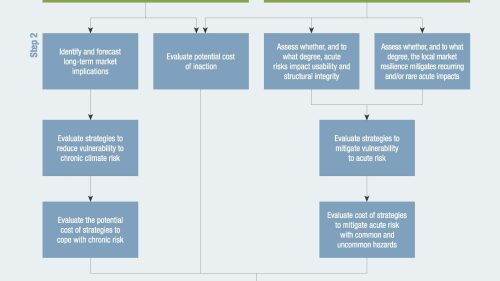All across America, surface parking lots dot metropolitan landscapes, serving the same solitary purpose day after day, a poster child for underutilized real estate.
But that is changing in some parts of the country. Parking lots are quietly becoming the new frontier in solar power.
While photovoltaic solar-panel installations are most often seen on swaths of vacant land or on top of buildings, parking lots are quickly emerging as a new hotspot for solar projects, primarily on the East and West Coasts. So far this year, thousands of solar panels have been constructed over parking lots at government offices in California, a football stadium in Maryland, a zoo in Ohio, and a corporate campus in New Jersey, among other places.
“You have this huge, massive, underutilized resource in this country—parking lots—and people are starting to figure out it’s the best place to install solar,” says Desmond Wheatley, president and CEO of California-based Envision Solar, a firm that specializes in the development of solar parking installations.
Large-scale parking lots are becoming increasingly popular for solar power because they are wide-open outdoor spaces that cover a large footprint, typically larger than building rooftops. Plus, because the panels are raised 12 to 20 feet (3.6 to 6 m) off the ground, they provide the additional benefit of shade for the cars parked underneath them. Thus, solar parking products and projects often use terms connoting shade, such as “solar trees,” “solar canopies,” “solar shields,” and “solar carports.”
“Solar parking lots are great green opportunities because you can put a roof over them and have the project serve two purposes,” says Margaret Cafarelli, principal of Urban Developments, a California development company specializing in green building practices, and a vice chair of ULI’s Sustainable Development Council.
Solar industry associations don’t keep specific statistics on parking-lot projects, but overall solar installations are booming in the United States, the result of growing interest in renewable energy, the availability of government incentives, plus steadily declining panel costs. The amount of photovoltaic energy installed in 2010 was double 2009’s level, in terms of megawatts produced, and installations in the first half of this year are up 70 percent over the same period last year, according to quarterly surveys and research conducted by the Solar Energy Industries Association in Washington, D.C., and Greentech Media Research in Boston.
About two-thirds of U.S. solar projects this year have occurred on nonresidential commercial real estate. In parking lots, solar projects are usually constructed in one of two ways: the traditional row after row of raised rectangular strips; or column after column of single pole-mounted panels, resembling a grove of trees. Likewise, project deals are usually structured in one of two ways: a utility company or solar developer installs the solar system and either leases it to the property owner or makes lease payments to the property owner, depending on who uses the electricity.
For property owners, the benefits include lower energy costs on the site, reduced carbon emissions from using less plant-generated electricity, plus the public display of sustainable business practices. Overall, the return on investment for property owners can be in the range of 10 to 15 percent, according to Ryan Park, director of business development for REC Solar, a California-based solar installation firm that has designed parking-lot projects.
“It’s another way for real estate owners to make money,” Ryan says. “This is going to be a megatrend over the next decade.”
For now, solar installations overall and parking-lot projects are concentrated in California and New Jersey, but they are popping up in other states. Consider some of the largest projects of 2011 so far:
- The Cincinnati Zoo & Botanical Garden covered most of its main parking lot with a solar “canopy” composed of more than 6,000 panels, which are expected to produce about 20 percent of the zoo’s annual electricity need.
- The NFL’s Washington Redskins added 7,500 solar panels atop more than 800 parking spaces at its FedEx Field in Maryland, providing electricity for 20 percent of the stadium’s power on game days and 100 percent on all other days.
- Santa Clara County in metropolitan San Jose, California, embarked on a project to install more than 15,000 solar panels on nine parking lots at government offices, all of which is expected to save the county nearly $18 million in electricity costs over a 25-year period.
- Financial publisher Dow Jones & Co. completed the installation of more than 13,000 solar panels across 230,000 square feet (21,390 sq m) of parking at a corporate campus in New Jersey, generating about 15 percent of the power needs there.
Solar parking projects have also been mounted at schools, colleges, apartment buildings, police stations, even a national park (Yosemite in California). Basically, any place with a large lot is a potential candidate. But the industry is still in its infancy and lacking in uniformity, with different states offering different programs and incentives and setting different standards and policies.
“Why isn’t everyone doing these parking projects? There are a lot of people who don’t know the options, and it’s easy to be confused,” says Mike Taylor, director of research for the Solar Electric Power Association, an industry advocacy group in Washington, D.C. “It’s still a market in its early stages.”




